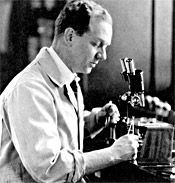The First Blood Bank

Peyton Rous at his microscope.
Courtesy of the Rockefeller Archive Center
During World War I, Peyton Rous (1879-1970), together with J.R. Turner, Jr., developed a simple method for preserving whole blood so that it could be used for transfusion. At that time, blood transfusions in hospitals were done by directly connecting a blood vessel of a donor to one of a recipient. On the frontlines of battle, however, this was impossible. Rous already had been studying blood proteins. Disturbed by reports of soldiers dying from blood loss, in 1915 he and his coworkers set about searching for a blood substitute, but when that proved to be too difficult, for a way to store whole blood without damaging the red cells.
Experimenting with blood from rabbits, dogs, and sheep, as well as human blood, Rous tested various solutions to anticoagulate the blood and preserve the red blood cells. He and his coworkers soon arrived at a formula: a standard physiological salt solution called Locke's solution, with sodium citrate added to prevent clotting, and dextrose, a sugar, as a source of energy for the red cells. After animal studies to test transfusion of the preserved cells proved successful, Rous's colleague Oswald H. Robertson went to Belgium with the U.S. Army Medical Corps in 1917 to try the technique on the battlefield. Finding blood donors among camp personnel, he performed many life-saving transfusions. His ice chest stocked with flasks of blood is credited as the world's first blood bank, and surely the first mobile one! Although it was not adopted by civilian hospitals, during World War II, the so-called Rous-Turner solution again came into use.
Peyton Rous received the BA from The Johns Hopkins University in 1900, and the MD from that university's Medical School in 1905. After teaching pathology at the University of Michigan, he joined the Rockefeller Institute in 1909, becoming a full member (professor) in 1930. He remained at Rockefeller his entire career. Among dozens of awards and honorary degrees, he received the National Medal of Science (1965), the Lasker Award (1958), and the Nobel Prize (1966). Rous also was elected to the U.S. National Academy of Sciences. He served as an editor of the Journal of Experimental Medicine from 1922 to 1970.
Selected Publications
Rous P and Turner JR. The preservation of living red blood cells in vitro: I. Methods of preservation. J Exp Med, 1916, 23:219-237
Rous P and Turner JR. The preservation of living red blood cells in vitro: II. The transfusion of kept cells. J Exp Med, 1916, 23:239-248
Oswald H. Robertson. British Medical Journal 1918. Article on blood preservation, transfusion during WWI.
Robertson OH. Presentation of the Kober Medal to Peyton Rous. Trans Assoc Am Phys, 1953, 66:20-26
Rous P. Acceptance of the Kober Medal for 1953. Trans Am Assoc Phys, 1953, 66:27-30
Further Reading
Corner GW. A History of the Rockefeller Institute, 1901-1953. New York: Rockefeller Institute Press, 1964
